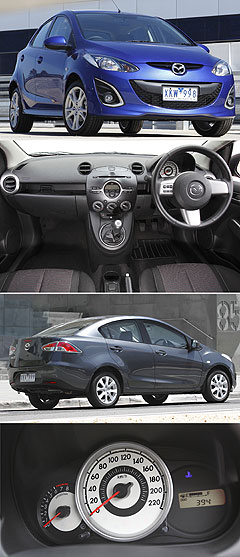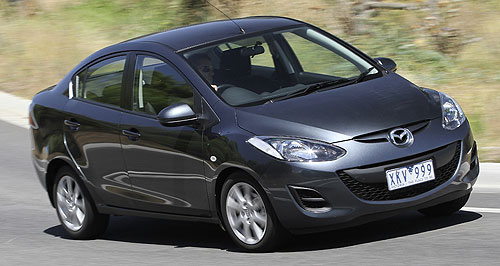New models - Mazda - Mazda2 - rangeFirst drive: New-look Mazda2 ready for light-fightGetting the boot: New Thai-built Mazda2 gets a sedan variant alongside the hatch. Facelifted Thai-built Mazda2 hatch and sedan range arrives ahead of new assassins4 May 2010 MAZDA has readied its smallest model for an impending light-car title fight against an array of new Chinese, Korean and Malaysian models this year by releasing a facelifted, better value Mazda2 line-up from Thailand, comprising the first sedan derivative. Visually differentiated by Mazda’s new corporate face, the 2010 Mazda2, which arrives with claimed value improvements of at least $1000 across the range, also features upgraded suspension and braking systems. The fresh Mazda2 will be joined this year in the cut-throat light-car segment by a sub-$12,000 S16 sedan from Proton, the all-new i20 hatch from Hyundai, Volkswagen’s redesigned Polo hatch, a new Barina line-up from Holden and the first passenger cars from Chery, Great Wall, Geely and Lifan. While the Mazda2 three-door has been axed along with its $16,030 starting price, the five-door Mazda2 hatchback entourage again consists of three variants, led by the entry-level Neo manual, which at $16,500 is priced $505 lower than the model it replaces. An automatic transmission continues to add $1650 to the price of all models. Throw in its increased standard specifications, which in the Neo’s case includes the addition of electronic stability and traction control – a potentially life-saving safety feature that is now standard across the Mazda2 range – and, according to Mazda, the Neo is $1005 more affordable than before.  The base Mazda2 Neo manual is also available now at a national driveaway price of $16,990 on the road, making it less expensive than the cheapest five-door Ford Fiesta, Holden Barina, Honda Jazz, Suzuki Swift, Toyota Yaris and all light-sized European models. The base Mazda2 Neo manual is also available now at a national driveaway price of $16,990 on the road, making it less expensive than the cheapest five-door Ford Fiesta, Holden Barina, Honda Jazz, Suzuki Swift, Toyota Yaris and all light-sized European models.That is despite the fitment of Mazda’s DSC stability and TSC traction control systems, plus standard equipment including twin front airbags, five head restraints, ABS brakes with electronic brake-force distribution and emergency brake assist, remote central locking, air-conditioning, power windows/mirrors, 15-inch steel wheels, driver’s seat height adjustment and a four-speaker AM/FM/CD sound system with auxiliary jack for iPods and other MP3 players. Front and side curtain airbags are available on the entry-level Neo hatch, for $400. Similarly, the mid-range Mazda Maxx hatch manual is $25 cheaper than before at $19,090, which Mazda says represents a spec-adjusted saving of $1085, while the flagship Mazda Genki hatch is priced at $20,940 as a manual – $355 (or $1030 spec-adjusted) less than the model it replaces. The new Mazda2 sedan – Mazda’s first four-door light car since the 121 ‘bubble’ launched here in November 1990 – is available only in the mid-range Maxx grade, which for both hatch and sedan body styles adds front-side and curtain airbags as standard. Riding on the same 2490mm wheelbase but adding 200 litres of cargo space – for a total of 450 litres – and boasting a more aerodynamic drag coefficient than the hatch (0.30 v 0.32Cd), the Mazda2 Maxx sedan manual is priced at the same $19,090 as the Maxx hatch – or $20,740 as an auto. As with the hatch, the Maxx sedan’s rear doors contain cup-holders big enough for a 500ml bottle and its rear seat split/folds, while Mazda says its first light sedan in 20 years has one of the widest bootlid openings in its class. The sedan also comes with link-type hinges that do not rob boot space, as well as a rear-seat ski-port. In addition to the base Neo’s specifications, both Maxx sedan and hatch models add side and curtain airbags, a six-CD player with steering wheel controls, and a rear spoiler (hatch only), while the top-shelf Genki hatch adds 16-inch alloys, a leather-trimmed steering wheel, foglights and a sports bodykit. The latter comprises unique bumpers and side skirts, redesigned foglight bezels and black grille inserts, but all 2010 Mazda2s come with an evolution of the current models’ ‘dynamic and exquisite’ design theme incorporating a new five-point grille, while Mazda says the car’s lower beltline and side mirror positioning increases visibility. The facelifted Mazda2 is available in a choice of eight colours per body style. Six of them are mica/metallic, which is a no-cost option that is priced up to $395 on some rival models. The Mazda2’s youth-oriented cabin carries over into the upgraded model, albeit with new seat trims – a hard-wearing grey cloth with contrasting black for the Neo and a higher-quality black with red and grey highlights for Maxx and Genki variants. Likewise, the Mazda2 continues to be powered exclusively by a 76kW 1.5-litre 16-valve DOHC four-cylinder petrol engine with sequential valve timing (S-VT) and an intake manifold with ‘tumble swirl control valves’. Now Euro 4 emissions-complaint, the Mazda2 MZR 1.5 delivers 2Nm less peak torque (135Nm at 4000rpm), but continues to return combined fuel consumption of 6.4 litres per 100km as a five-speed manual and 6.8L/100km in four-speed automatic form. Average CO2 emissions are also unchanged at 152 grams per 100km (manual) and 162g/km (auto). The upgraded Mazda comes with a revised rear suspension system comprising twin-tube, rather than monotube, dampers – which Mazda says operate with less internal friction to improve ride comfort even on rough surfaces. Meantime, the carry-over twin-tube front dampers have also been retuned to improve roadholding and ride quality, while the standard Neo and Maxx suspension tune continues to differ from that of the Genki’s sportier set-up – via 10 per cent softer rebound and 10 per cent firmer compression damping up front, 30 per cent firmer rear dampers and 59 per cent stiffer anti-rollbars. Rounding out the mechanical updates is a revised brake master-cylinder to reduce pedal play. Mazda Australia forecasts 1100 sales of the facelifted Mazda2 a month, 60 per cent of which are expected to be Neo hatches, with Maxx sedan and hatch models accounting for 30 per cent and the Genki hatch 10 per cent. Automatic versions will comprise the lion’s share of sales – 65 per cent for the hatch and 75 per cent for the sedan, with the four-door expected to attract 20 per cent of total sales. The lighter, more stylish second-generation Mazda2 hatch was launched in Australia in September 2007 and, since then, has increased Mazda’s light-car sales by 170 per cent. According to Mazda, apart from attracting a high proportion of female buyers, the current model has reduced the average age of Mazda2 buyers by nine years. Mazda says it has sold more than one million examples of the first two generations in more than 80 countries, including more than 36,000 MkII Mazda2s in the past two and a half years. Mazda2 sales are down 5.7 per cent after the first three months of 2010, in which the model holds a 9.9 per cent share of Australia’s under-$25,000 light-car segment – behind the top-selling Yaris (16.7 per cent), Hyundai Getz (16.4 per cent) and Barina (11.6 per cent) but ahead of the Swift (9.3 per cent), Fiesta (9.0 per cent) and Jazz (7.6 per cent). As GoAuto has reported, the facelifted latest Mazda2 is built not in Japan but at Mazda and Ford’s state-of-the-art joint-venture passenger car plant in Thailand, which has a free-trade agreement with Australia.
 Quick testsRead moreAll new models Alfa Romeo Alfa Romeo Abarth Abarth Audi Audi Aston Martin Aston Martin BMW BMW Bentley Bentley Chrysler Chrysler Chevrolet Chevrolet Dodge Dodge Citroen Citroen Ferrari Ferrari DS DS Ford Ford Fiat Fiat FPV FPV Foton Foton Haval Haval Great Wall Great Wall Honda Honda Holden Holden Hyundai Hyundai HSV HSV Isuzu Isuzu Infiniti Infiniti Jeep Jeep Jaguar Jaguar Lamborghini Lamborghini Kia Kia Lexus Lexus Land Rover Land Rover Mazda Mazda Maserati Maserati Mercedes-Benz Mercedes-Benz McLaren McLaren Mini Mini Nissan Nissan Mitsubishi Mitsubishi Peugeot Peugeot Opel Opel Proton Proton Porsche Porsche Renault Renault Ram Ram Saab Saab Rolls-Royce Rolls-Royce Smart Smart Skoda Skoda Subaru Subaru SsangYong SsangYong Tesla Tesla Suzuki Suzuki Toyota Toyota Volvo VolvoMazda2 pricingMotor industry news |
|
||||||||||||||||||||||

















Facebook Twitter Instagram